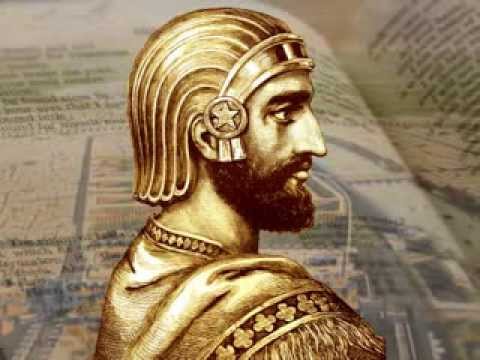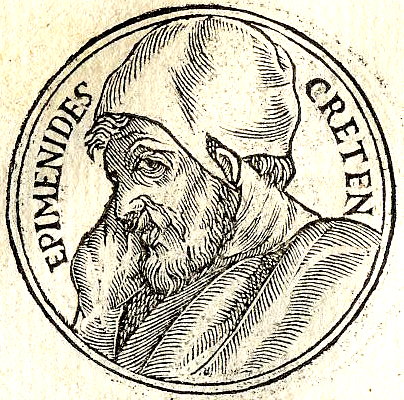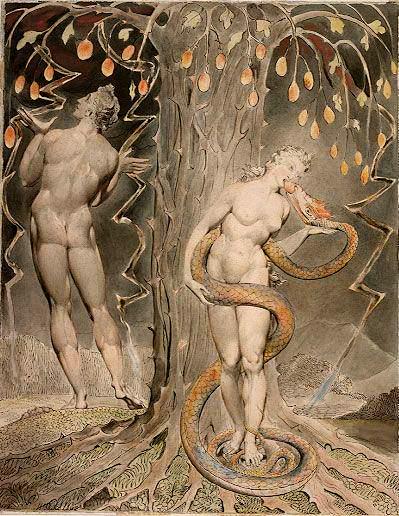In the Old Testament, Ezra (3.7) infers that Jews and Phoenicians renew commercial relations:
“So they gave money to the masons and the carpenters and food, drink and oil to the Sidonians and Tyrians to bring cedar trees from Lebanon to the sea to Joppa, according to the grant that they had from Cyrus, king of Persia.”
The Book of Ezra narrates a story of the first return of exiles in the first year of Cyrus, in which Cyrus boastfully proclaims: “All the kingdoms of the earth hath the LORD, the God of heaven, given me; and He hath charged me to build Him a house in Jerusalem, which is in Judah.”(Ezra 1:2)
To the ancient Phoenicians, King Cyrus had left a lasting legacy on their history in restoring both the Temple of Solomon and also their religion. He is referred to by the Jewish Bible as Messiah (lit. “His anointed one”) (Isaiah 45:1), and is said to be the only non-Jew to be called so:
“So said the Lord to His anointed one, to Cyrus.” — Isaiah 45:1-7
Cyrus being arrived at Knossus the Capital of Crete goes to see the Temple of Olympian Jupiter , & admires the structure & ornaments of it, 5. He meets there Pythagoras, 9. Who informs him of the doctrine of Orpheus concerning the Golden age , II. He also relates to kirn the public dispute he had with Anaximander , with the arguments on hath fides , & how he got the victory with the help of a Miracle , IJ-X5.
His further account of the dispute they Lid together in private , 07-37. Cyrus tills Pythagoras his opinion of the Laws of Egypt, Athens , Sparta , & Pythagoras shews him the Laws of Minos , & tells him why this institution did not last long in Crete, 39-43. Cymsafier leaving Greece , discourses with Araspes about the genius & learning of the Egyptians & Grecians • Araspes prefers the Egyptians for learning & the Greeks for politeness: Cyrus prefers the Greeks for both , & gives a description of true civility or politeness , 47. They are driven or the Isle of Cyprus & see the Temple of Paphos , but stay short while in that profane Island, 49.
THE SEVENTH BOOK.
Description of Tyre, 53. Cyrus meets there Amenophis , who relates to him how Arobal his former companion in prison was become King of Tyre & had drawn him thither, 55-. the King of Tyre entertains Cyrus most nobly , & informs him of the measures he had tahen tot mahe trade stourish & to procure the plenty & riches which Cyrussaw & admired in that City , 65. &C. Cyrus is called home to be present at the death of his.
A new Cyropaedia or the travels of Cyrus, Volume 1
By Andrew Michael Ramsay
The King esteemed and loved Pythagoras, yet he suffered himself to be deceived by the artful representations of Anaximander: the Sage was banished from court obliged to quit his country. He leads at present a retired lise in the island of Crete, and there studies wisdom without books or conversation. Having searched deep into all t”e mysteries of nature, and discerned those marks of an infinite Wisdom and Power, with which every part of the universe abounds, he soars upon the wings of contemplation, that he may unite himself to the sovereign truth, whose impressions he receives without the medium of words or sounds*.
This inspiration as I am told, -is nothing like that enthusiasm which heats the mind and agitates the body; but it gradually stills the noise of the senses and imagination, imposes silence on all vain reasonings, and brings the soul to an inward calm, that resembles the repose of the Gods themselves, whose infinite activity does not in the least diminished their perfect tranquility. In this sublime state Pythagoras practices all the human and social virtues, but it is with an ultimate regard to the Gods, and in imitation of their veracity and goodness ; he is modest, affable, polite, delicate in all his sentiments, disinterested in all his actions, speaks little, and never displays his talents but to inspire the love of virtue. This account of the Samian Philosopher gave Cyrus a great desire to see him, and 10 learn the particulars fs his dispute. The wind continued savorable, and the vessel in a sew days made the ifland of Crete.
The Travels of Cyrus, 1: To which is Annexed a Discourse Upon the Theology …
By Andrew Michael Ramsay
In An Encyclopedia of Freemasonry and Its Kindred Sciences …, Volume 1 By Albert Gallatin Mackey, Edward L. Hawkins, William James Hughan
Cyrus. Cyrus, King of Persia, was a great conqueror, and after having reduced nearly all Asia, he crossed the Euphrates, and laid siege to Babylon, which he took by diverting the course of the river which ran through it. The Jews, who had been carried away by Nebuchadnezzar on the destruction of the Temple, were then remaining as captives in Babylon. These Cyras released A.m. 3466, or B.c. 538, and sent back to Jerusalem to rebuild the house of God, under the care of Joshua, Zerubbabel, and Haggai. Hence, from this connection of Cyrus with the history of Masonry, he plays an important part in the rituals of many of the high degrees.
But from late discoveries of inscriptions pertaining to Cyrus, as mentioned in the excellent little London work called Fresh Light from the Ancient Monuments (pp. 166-186), A. H. Sayce, M.A., it would appear that this king was a polytbeist, and that he was not a king of Persia, although he acquired that country after his conquest of Astyages, B.c. 559, between the sixth and ninth years of Nabonidos. Cyrus was king of Elam. The empire he founded was not a Persian one; Darius, the son of Hystaspes, at a subsequent period, was the real founder of that kingdom. Prof. Sayce continues: “It was only as the predecessor of Darius, and for the sake of intelligibility to the readers of a later day, that Cyrus could be called a king of Persia.” (Ezra i. 2.) The original words of his proclamation, “King of Elam,” have been changed into the more familiar and intelligible “King of Persia.” Elsewhere in the Bible (Isa. xxi. 1-10), when the invasion of Babylon is described, there is no mention of Persia, only of Elam and Media, the ancestral dominions of Cyrus. This is in strict accordance with the revelations of the Monuments, and testifies to the accuracy of the Old Testament records.
Cyrus never besieged Babylon, a city fifteen miles square. It opened its gates to his general without battle, B.c. 538. The description by Herodotus belongs to the reign of Darius. Mr. Bosanquet asserts that the Darius of the Book of Daniel is Darius the son of Hystaspes.
Cyrus had learned that a disaffected conquered people imported into a kingdom was a constant menace and danger, and he returned the Jewish exiles to Jerusalem to rebuild their city and be a fortress and check upon Egypt. The nations which had been brought from East and West were restored to their lands along with their gods. So it was with the captives of Judah. His dominions extended from the Hellespont almost to India.
Cyrus was a worshiper of Merodach. Originally the Sun-god, who is mentioned and intended by the name Bel, and Nebo, his prophet. (Isa. xlvi. 1.) His first act after acquiring Babylonia was to restore the Babylonian gods to their shrines, from which they had been removed by Nabonidos, and further asks for their intercession. The theory that Cyrus believed in but one supreme god—Ormudz— must be abandoned. God consecrated Cyrus to be His instrument in restoring His chosen people to their land, not because the King of Elam was a Monotheist, but because the period of prophecy, “ten weeks of years,” was drawing to a close.
These statements are made upon the authority of the three inscriptions among the clay documents lately discovered in Babylonia by Mr. Rassam, and translated by Sir Henry Rawlinson and Mr. Pinches. The first of these is a cylinder, inscribed by order of Cyrus; the second a tablet, which describes the conquest of Babylonia by Cyrus; while the fourth letter of the Phoenician, the Hebrew, the Greek, the Roman, and of nearly all alphabets. In Hebrew it is “1, Daleth, signifying the door of life, a representation of which was probably its original hieroglyph, thus:shows the approximation to the Hebrew Daleth; 2, the Greek Delta, resembling the opening of a tent. The numerical value of “I is four; as a Roman numeral it stands for 500. The Divine name in Hebrew connected with this letter is Daghul, Insignis.

Moe is the founder of GnosticWarrior.com. He is a father, husband, author, martial arts black belt, and an expert in Gnosticism, the occult, and esotericism.



![How St. Augustine in Kent followed the doctrine and manner of life of the primitive Church, and settled his episcopal see in the royal city [597 A. D.] | Book 1 Chapter 25 How St. Augustine in Kent followed the doctrine and manner of life of the primitive Church, and settled his episcopal see in the royal city [597 A. D.] | Book 1 Chapter 25](https://www.gnosticwarrior.com/wp-content/plugins/contextual-related-posts/default.png)

